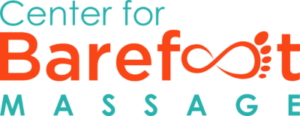In Part 1 of Antibiotics, Viruses, and Barefoot Massage, I talked about 4 types of common viruses and when how long you should avoid contact with your massage clients who have these viruses. Today, it’s all about antibiotics.

Both viruses and bacteria can be spread by inhalation of microorganisms or spores via close personal contact, via sneezing, coughing, or even laughing.
Remember that antibiotics don’t work for viruses, but they’re instead used to fight the bacteria harmful to human health. We’ll go over bad bacteria types, different antibiotics, what they’re used for, and how this affects your barefoot massage.
While antibiotics may be taken preventively (say, prior to oral surgery), for the sake of this blog we’ll assume that your massage client is taking antibiotics to fight a systemic infection.
As Nicole Cutler, L.Ac states, “As members of the healthcare industry, bodyworkers and their environment are particularly prone to pathogen exposure.”

Let’s get your anatomy nerd brain on!
3 groups of bacteria
- Aerobic – love oxygen and causes staphylococcal or streptococcal infections.
- Anaerobic- canNOT live on gaseous oxygen. Responsible for gangrene, botulism, & tetanus.
- Facultative anaerobes- would prefer oxygen but can live without it. Salmonella and Escherichia Coli are facultative anaerobes.
In order to survive bacteria needs food, moisture, and nutrients. Some, however, don’t even need light or oxygen and are quite happy snuggled up inside you. And they replicate, fast.
Bacteria make copies of themselves, using binary fission, amazingly fast – as fast as once every 20 minutes! That means if you have 1 bacterium at 9am on Monday, by noon you will have 512, by 4pm you will have over 2 million and by the time you go to bed (8pm) you will have nearly 9 thousand million!
-Microbiode Magic
Types of Antibiotics and what they’re used for
Aminoglycosides
Are often injected into veins or muscles but may be used topically to treat eye infections.
Anaerobic Antibiotics
Used for bacteria that cause internal infection and thrive with no oxygen.
Cephalosporins
Destroy the outer cell wall and kills the bacteria.
Macrolides
Prevent the production of bacteria’s proteins, which kills the bacteria.
Oxazolidinones
Typically used to treat skin infections, resistant infections and pneumonia.
Penicillins
Destroy the outer wall of the bacteria, which kills it.
Quinolones
Halts growth of bacteria, which eventually causes bacterial death.
Rifamycins
Slows reproduction of certain types of bacteria.
Sulfonamides
Kills bacteria by interfering with the enzyme that helps form folic acid.
Tetracyclines
Bacteria is destroyed when the medication prevents it from producing proteins.

Massage specific side effects of antibiotics
✓nausea
✓numbness of hands and feet
✓tingling of hands and feet
✓drowsiness
✓headache
✓stomach cramping
How long to wait if your massage client is on antibiotics
Just because your client started taking antibiotics does NOT mean they are fine to get your barefoot massage or even hands-on massage.
Remember that if your client has the classic symptoms of infection, general malaise (feels like crap), heat in a specific area or fever, redness, swelling, and is still in pain, the antibiotics still need time to work.
Ruth Werner states that massage is contraindicated when the client has an active, acute infection.
While antibiotics DO work quickly, the client will often not feel better for a few days. In fact, most antibiotics are most effective when taken for 7-10 days.
The 3-day rule
In general, bodywork is considered safe if the client has been taking antibiotics for at least three days, the infection is not systemic and none of the signs of current infection are present: heat, fever, swelling or pain.
-Nicole Cutler, L.AcJane Brown, director of the 1,000-hour massage program at Carnegie Institute in Troy, Mich., reminds us, “All antibiotics have different saturation levels in the blood; so although the three-day rule holds most of the time, you never really know which antibiotic has reached its height of effectiveness and when.”
-Charlotte Michael Versagi, LMT, NCTMB
If your client has been on antibiotics for at least 3 days, be mindful of the potential side effects listed above. If she or he is presenting with dizziness or nausea, avoid rocking or ROM (range of motion).
If your massage client presents with the following, call the doctor:
✓ unexplained rash
✓ unexplained joint pain
✓ increased difficulty breathing
✓ severe and fast onset headache
✓ swelling of lips, tongue, or face
✓ recently occurring muscle fatigue which doesn’t usually occur with client
✓ unexplained bruising not caused by high doses of blood thinners
✓ unexplained swelling
As a final note, use your best judgment.
If something feels “off” to you but technically you’re allowed to work on them, you may consider holding doing your barefoot or hands-on massage until the course of antibiotics has been finished.

Mary-Claire Fredette, instructor & co-founder of Center for Barefoot Massage was probably the only one of her friends in college who loved writing research papers.
You can learn more about her and register for a class (usually in Cincinnati) by going here.
Sources
The Essential Massage Companion – Dr. Bryan Born
A Massage Therapist’s Guide to Pathology – Ruth Werner
Microbemagic.ucc.ie
Medicinenet.com
Advancedtissue.com
And the following are excellent articles on the subject if you’d like to get 2 feet deep the use of antibiotics in your massage practices:
Massage Today
Institute for Integrative Healthcare


Please note: we reserve the right to delete comments that are offensive or off-topic.